Published
- 15 min read
Complete Guide to Modern Software Deployment Services

Software deployment has transformed from a slow, manual task into a streamlined, often fully automated process. Over the past decade, the rise of modern deployment services has made it possible for teams to release features, updates, and fixes at a pace that matches business and user expectations.
In 2025, adopting a modern software deployment service is no longer a luxury, it is a necessity. Teams that leverage these platforms enjoy significant advantages in speed, stability, and scalability. They can deploy code with fewer errors, recover from failures quickly, and scale applications seamlessly as demand grows.
This complete guide explains what software deployment services are, the benefits they provide, the challenges teams face when adopting them, and the key factors to consider when selecting the right platform. It also highlights how automation, cloud integration, and AI-powered tools are reshaping deployment strategies for teams of all sizes.
What Are Software Deployment Services?
Software deployment services are specialized platforms, tools, or managed systems that automate and manage the process of moving an application from development to a live production environment. These services take care of all the technical steps involved, ensuring your software is built, packaged, delivered, and configured correctly so it can run smoothly for end users.
A typical deployment service will handle tasks such as:
- Compiling source code into executable files or container images
- Packaging the application into deployable units like Docker containers, binaries, or serverless functions
- Transferring artifacts to servers, containers, or cloud environments
- Configuring environment variables and settings so the application behaves as expected
- Executing database migrations and other pre-launch steps
Modern deployment services go beyond just moving code to production. They integrate directly with your code repository (for example, GitHub or GitLab), making it possible to trigger deployments automatically whenever new code is pushed. This continuous integration and continuous deployment (CI/CD) approach reduces manual effort, shortens release cycles, and minimizes human error.
Many platforms also provide:
- Rollback functionality to quickly restore a previous stable version if something breaks
- Monitoring and alerting tools to track application health and performance after deployment
- Multi-environment support, allowing you to deploy separately to development, staging, and production environments
By using a software deployment service, teams can ensure consistent, reliable releases, reduce operational overhead, and free up developers to focus on writing code rather than managing infrastructure.
Why Modern Deployment Services Matter
In 2025, software products are updated more frequently than ever before. Users expect regular feature enhancements, quick bug fixes, and performance improvements. At the same time, competition in software markets is fierce, and teams that cannot release quickly risk falling behind. A slow or unreliable deployment process forces teams to spend valuable time fixing release issues instead of focusing on innovation.
Modern deployment services address this challenge by introducing automation, consistency, and scalability into the release process. They ensure that applications can move from development to production quickly and with fewer errors. This makes them essential for any team that wants to stay competitive.
Key reasons modern deployment services matter include:
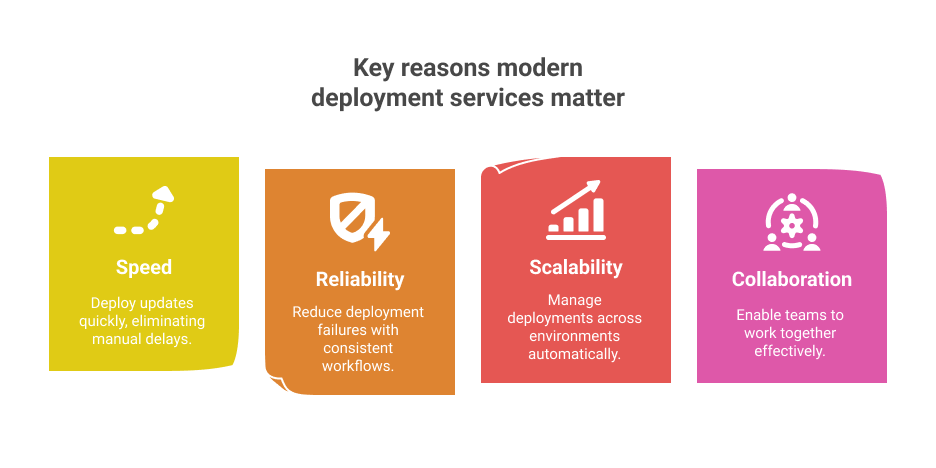 1. Speed Deploy new features, bug fixes, or updates in minutes rather than hours. Automated processes eliminate unnecessary steps and reduce manual delays.
1. Speed Deploy new features, bug fixes, or updates in minutes rather than hours. Automated processes eliminate unnecessary steps and reduce manual delays.
2. Reliability Use consistent, repeatable workflows to reduce the risk of deployment failures. Automated validation and rollback capabilities ensure that issues can be resolved quickly.
3. Scalability Manage multiple microservices, environments, or global deployments without relying on manual coordination. Modern tools can automatically adjust resources based on demand.
4. Collaboration Enable developers, QA teams, and operations teams to work together more effectively. Integrated deployment pipelines keep everyone aligned on the status of releases.
Modern deployment services are not just a convenience. They are a strategic necessity for teams that want to improve release velocity, maintain application stability, and scale efficiently.
Core Features to Look For in Software Deployment Services
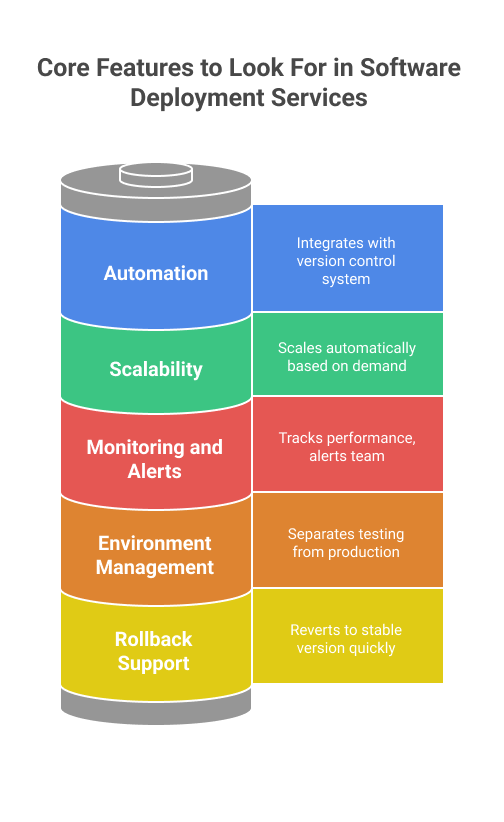 When choosing a software deployment service, the right set of features can make a significant difference in your team’s ability to release updates quickly, safely, and at scale. The goal is to select a platform that not only fits your current needs but can also grow with your application and business.
When choosing a software deployment service, the right set of features can make a significant difference in your team’s ability to release updates quickly, safely, and at scale. The goal is to select a platform that not only fits your current needs but can also grow with your application and business.
1. Automation
Modern deployment services should integrate directly with your version control system, enabling fully automated deployments. This removes manual steps, reduces the chance of human error, and speeds up the release process. Automated pipelines also make it easier to maintain a consistent deployment process across all environments.
2. Rollback Support
Even the most thoroughly tested releases can run into unexpected issues in production. A strong deployment platform includes rollback functionality, allowing your team to revert to a previous stable version within minutes. This minimizes downtime, improves reliability, and protects the user experience.
3. Environment Management
Effective deployment services allow you to separate and manage multiple environments such as development, staging, and production. This ensures that changes can be tested thoroughly before reaching end users, reducing the risk of production errors.
4. Scalability
Your chosen platform should be able to scale your application automatically based on real-time demand. Scalability without downtime is essential for handling traffic spikes, maintaining performance, and delivering a smooth user experience.
5. Monitoring and Alerts
Deployment does not end when code goes live. Post-deployment monitoring tools track application performance and error rates in real time, while alert systems notify the right team members as soon as issues arise. This enables faster response times and proactive problem-solving.
By focusing on these core capabilities, teams can ensure that their software deployment process is efficient, resilient, and ready to support continuous delivery in 2025.
Benefits of Using Modern Deployment Services
 Adopting a modern software deployment service can transform how your team delivers applications. These platforms are not just about moving code from development to production, they are about improving speed, quality, and operational efficiency. Below are the key benefits.
Adopting a modern software deployment service can transform how your team delivers applications. These platforms are not just about moving code from development to production, they are about improving speed, quality, and operational efficiency. Below are the key benefits.
Faster Releases : Automated pipelines replace manual deployment steps, allowing teams to push updates to live environments in minutes. This reduces the time between writing code and delivering value to end users.
Improved Quality : Modern deployment services often integrate automated testing, environment consistency checks, and monitoring tools. These features reduce the likelihood of production bugs and help maintain application stability.
Lower Operational Costs : By removing repetitive manual tasks, teams can spend less time on deployment management and more time on feature development. This efficiency often leads to cost savings, especially for teams managing multiple services or environments.
Greater Flexibility : Modern platforms support various architectures, including microservices, serverless applications, and containerized workloads. This flexibility allows teams to adopt the best approach for each project without being tied to a single deployment model.
Challenges in Software Deployment
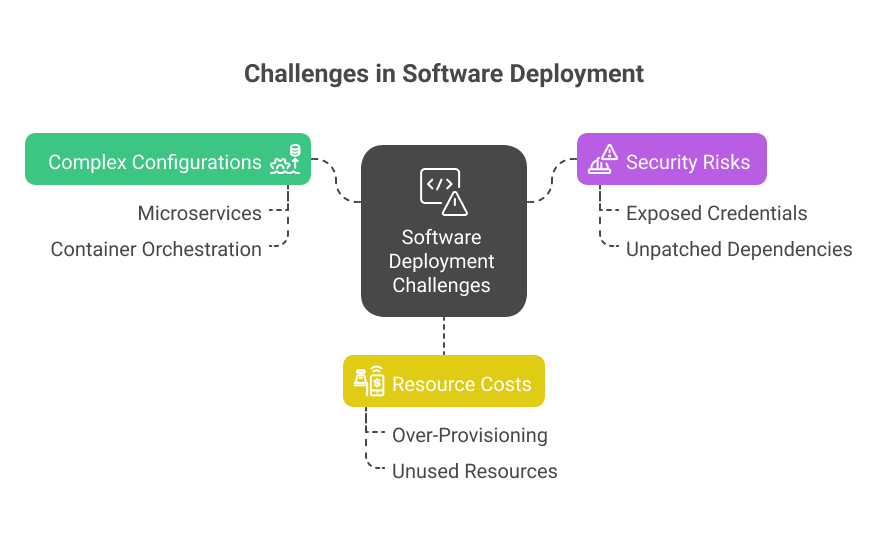 Even with modern deployment services and automation, teams still face challenges that can slow down releases or impact reliability. Understanding these risks is the first step toward avoiding them.
Even with modern deployment services and automation, teams still face challenges that can slow down releases or impact reliability. Understanding these risks is the first step toward avoiding them.
Complex Configurations Managing multiple environments, dependencies, and services can become difficult without strong configuration management. This is especially true in setups involving microservices or container orchestration, where a single misconfiguration can cause deployment failures.
Security Risks Software deployments can unintentionally introduce vulnerabilities if security is not prioritized. Issues like exposed credentials, unpatched dependencies, and insecure deployment scripts can create entry points for attackers.
Resource Costs Some deployment platforms can become expensive at scale, particularly if environments are over-provisioned or unused resources are left running. Without regular cost monitoring and optimization, cloud expenses can quickly increase.
For detailed strategies to overcome these challenges and make deployments faster, safer, and more cost-efficient, see this complete guide on automating deployments.
Examples of Modern Deployment Services
When exploring software deployment services, it helps to know what platforms are leading the market in 2025. Each option has its strengths, depending on your team size, technical needs, and growth plans.
Kuberns
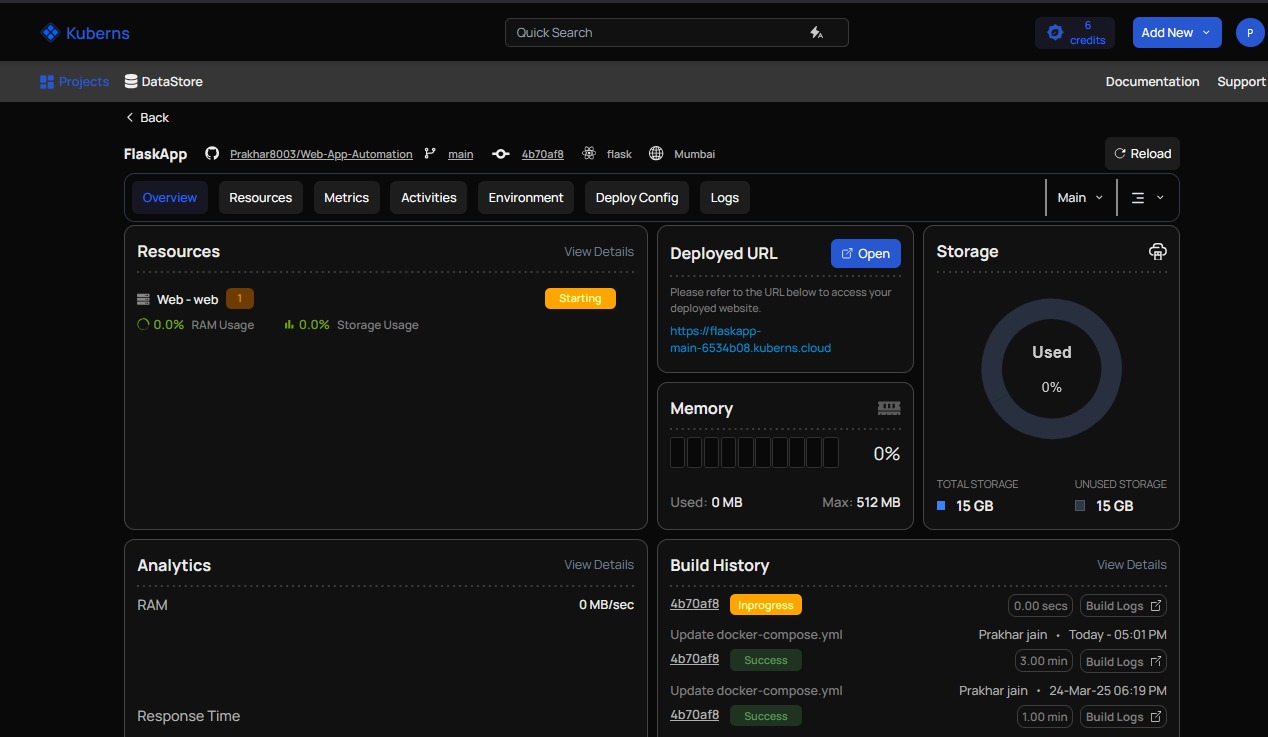 Kuberns is an AI-powered software deployment service designed to simplify the entire delivery process. It supports Git-based deployment triggers, automated scaling for microservices, built-in rollback, and post-deployment monitoring. A key differentiator is its ability to deliver up to 40% AWS cost savings by optimizing cloud usage. Kuberns is suitable for teams that want automation, scalability, and cost efficiency without managing complex infrastructure. For a deeper look at its capabilities, read this guide to AI-powered deployment.
Kuberns is an AI-powered software deployment service designed to simplify the entire delivery process. It supports Git-based deployment triggers, automated scaling for microservices, built-in rollback, and post-deployment monitoring. A key differentiator is its ability to deliver up to 40% AWS cost savings by optimizing cloud usage. Kuberns is suitable for teams that want automation, scalability, and cost efficiency without managing complex infrastructure. For a deeper look at its capabilities, read this guide to AI-powered deployment.
Render
 Render is a developer-friendly deployment platform offering Git-based deployments, automatic SSL, autoscaling, and background jobs. It works well for small to mid-sized teams that want a balance of simplicity and control without needing to maintain their own servers.
Render is a developer-friendly deployment platform offering Git-based deployments, automatic SSL, autoscaling, and background jobs. It works well for small to mid-sized teams that want a balance of simplicity and control without needing to maintain their own servers.
See how Render compares to Kuberns →
Railway
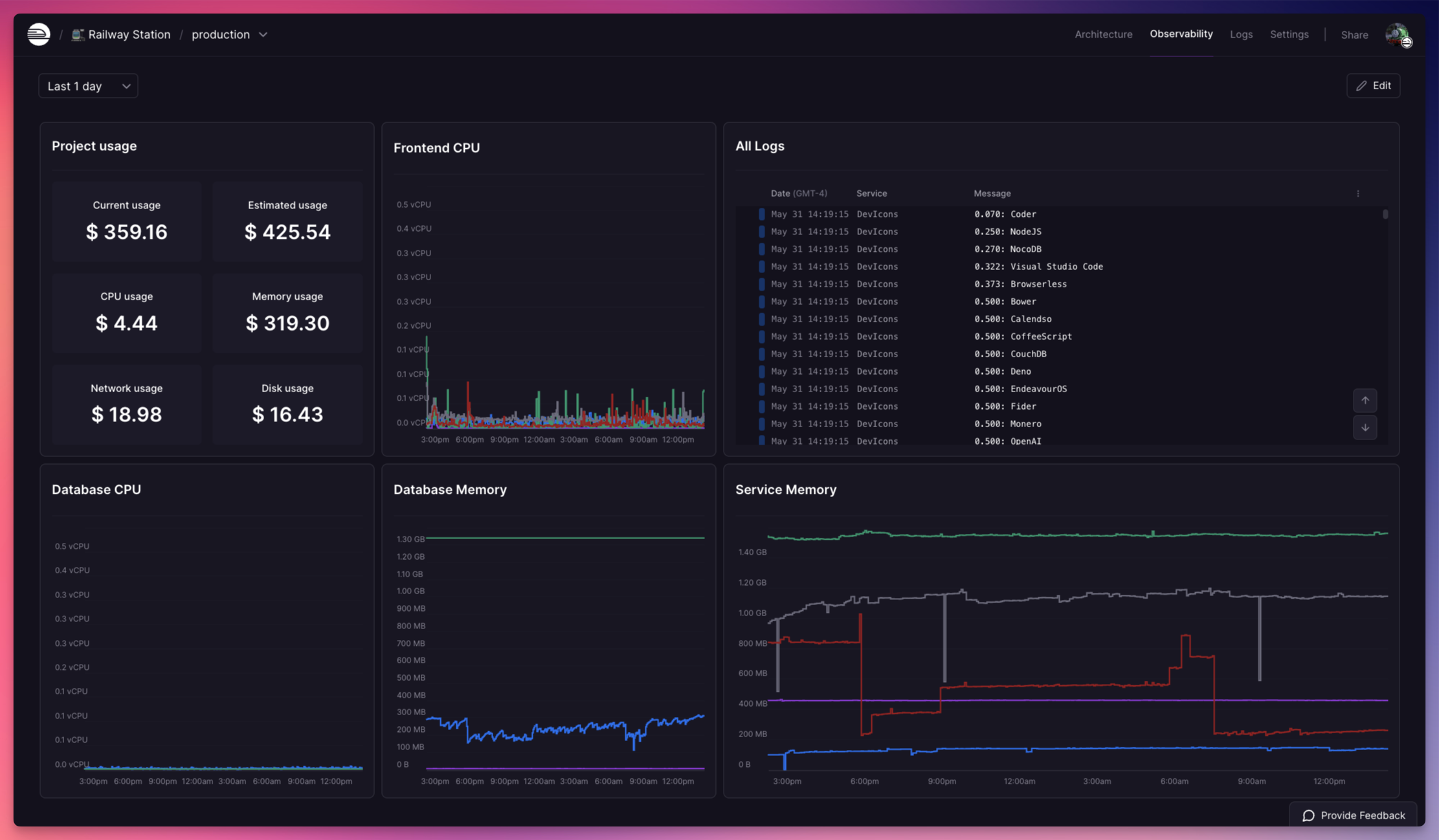 Railway is known for its simplicity and beginner-friendly interface. It allows quick deployments without deep infrastructure knowledge, making it a good fit for smaller projects, MVPs, and hackathons. While it lacks advanced scaling and multi-service orchestration, it’s popular for rapid prototyping.
Railway is known for its simplicity and beginner-friendly interface. It allows quick deployments without deep infrastructure knowledge, making it a good fit for smaller projects, MVPs, and hackathons. While it lacks advanced scaling and multi-service orchestration, it’s popular for rapid prototyping.
See how Railway compares to Kuberns →
AWS CodeDeploy
 AWS CodeDeploy is a fully managed deployment automation service from Amazon Web Services. It supports automated rollouts to EC2 instances, AWS Lambda functions, and on-premise servers. Its deep integration with the AWS ecosystem makes it ideal for organizations already committed to AWS infrastructure.
AWS CodeDeploy is a fully managed deployment automation service from Amazon Web Services. It supports automated rollouts to EC2 instances, AWS Lambda functions, and on-premise servers. Its deep integration with the AWS ecosystem makes it ideal for organizations already committed to AWS infrastructure.
How to Choose the Right Software Deployment Service
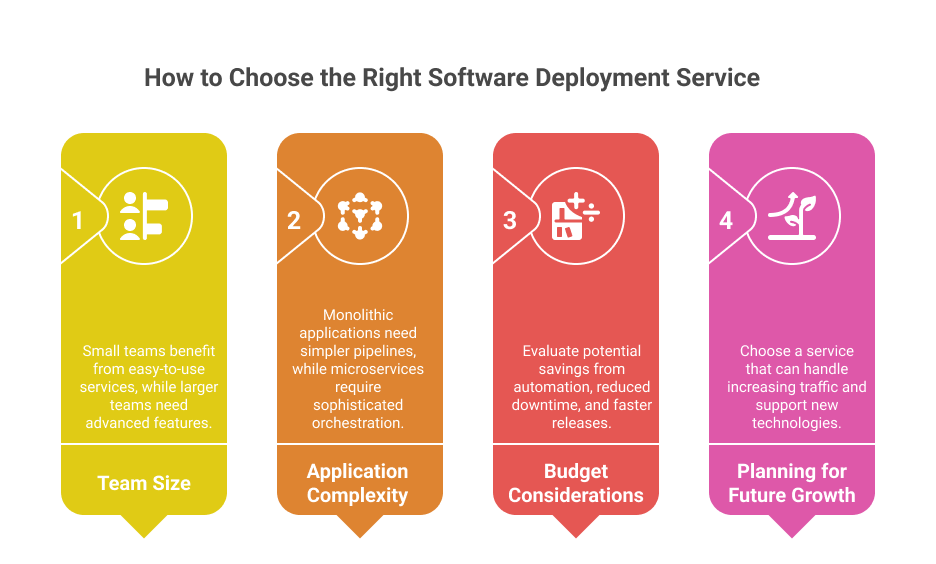 Selecting the right software deployment service is not just about picking a popular platform. The decision should align with your team’s size, your application’s complexity, and your long-term growth plans. Making the right choice early can save you time, reduce costs, and prevent operational headaches as your product evolves.
Selecting the right software deployment service is not just about picking a popular platform. The decision should align with your team’s size, your application’s complexity, and your long-term growth plans. Making the right choice early can save you time, reduce costs, and prevent operational headaches as your product evolves.
1. Team Size If you are a small team, you may benefit from a straightforward, easy-to-use deployment service that minimizes setup and configuration. Larger teams often require advanced features such as role-based access control, audit logs, and integration with multiple development tools to manage more complex workflows.
2. Application Complexity The type of application you are deploying matters. A monolithic application may work well with a simpler deployment pipeline, while microservices, containerized applications, and serverless architectures require more sophisticated orchestration, environment management, and monitoring capabilities.
3. Budget Considerations Look beyond the subscription or hosting cost of the platform. Evaluate the potential savings from automation, reduced downtime, and faster releases. A slightly higher monthly fee for a platform with strong automation can be more cost-effective in the long run.
4. Planning for Future Growth Choose a service that can grow with your business. This includes the ability to handle increasing traffic, deploy across multiple regions, support new technology stacks, and integrate with emerging tools.
Pro Tip: If you want a platform that combines ease of use with scalability, built-in automation, monitoring, and cost optimization, consider solutions like Kuberns that are designed to support both startups and enterprise-level workloads.
Final Thoughts
Modern software deployment services have moved from being optional to essential for any team that wants to stay competitive in 2025. These services streamline releases, reduce downtime, and enable teams to ship features at a pace that matches user expectations. By automating key steps, improving consistency across environments, and offering real-time monitoring, they allow teams to spend more time building value and less time fixing avoidable problems.
For organizations that want to combine automation, scalability, and intelligent cost management, Kuberns offers a complete solution. It provides Git-based deployments, automatic scaling, built-in rollbacks, and monitoring, while helping teams save up to 40 percent on AWS costs. The platform removes the complexity of managing infrastructure and delivers production-ready applications in minutes.
If your current deployment process feels slow or unreliable, it may be time to adopt a smarter approach. We built Kuberns to solve these exact challenges. See how it works.

Frequently Asked Questions About Modern Software Deployment Services
What is a software deployment service?
A software deployment service is a platform, tool, or managed system that automates the process of moving an application from development to a live environment. It handles compiling, packaging, transferring, and configuring your application so it runs correctly in production.
Why are modern deployment services important in 2025?
Modern deployment services are essential because they help teams release updates faster, reduce errors, and improve scalability. With user expectations for continuous improvements and high availability, slow or manual deployments can cause delays, bugs, and customer dissatisfaction.
What are the core features I should look for in a deployment service?
Key features include automated deployments from version control, rollback capabilities, environment management for dev, staging, and production, scalability options, and post-deployment monitoring with real-time alerts.
How do deployment services improve application quality?
By automating repetitive steps, enforcing consistent environments, and integrating with testing tools, deployment services reduce human error. This consistency helps catch bugs early and ensures applications perform reliably after release.
Can deployment services help reduce costs?
Yes. Automation reduces the need for manual deployment work, freeing up developers and operations staff to focus on building features. This efficiency lowers operational overhead and can also optimize infrastructure usage.
Are modern deployment services suitable for microservices and serverless applications?
Absolutely. Many modern deployment platforms are designed to handle microservices, serverless functions, and containerized applications. They provide independent scaling, routing, and management for each service, making them ideal for complex architectures.
Do I need DevOps expertise to use a deployment service?
Not necessarily. While some advanced tools require DevOps skills, many modern platforms focus on simplicity and can be used by developers without deep infrastructure knowledge. Services like Kuberns make deployment accessible with one-click setups and AI-powered automation.
How can I choose the right deployment service for my team?
Consider your project’s size, complexity, and growth plans. Evaluate platforms based on automation capabilities, integration options, scalability, ease of use, and cost. If you need a balance of power, cost efficiency, and simplicity, explore platforms like Kuberns that are built for modern team workflows.